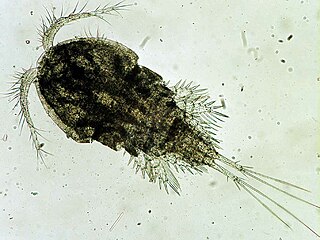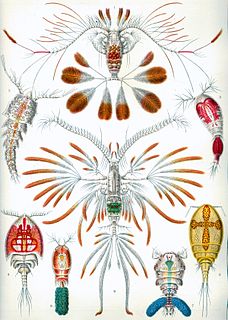Related Research Articles
Tantulocarida is a highly specialised group of parasitic crustaceans that consists of about 33 species, treated as a subclass of the class Hexanauplia. They are typically ectoparasites that infest copepods, isopods, tanaids, amphipods and ostracods.

Siphonostomatoida is an order of copepods, containing around 75% of all the copepods that parasitise fishes. Their success has been linked to their possession of siphon-like mandibles and of a "frontal filament" to aid attachment to their hosts. Most are marine, but a few live in fresh water. There are 39 recognised families:
Deoterthridae is a family of crustaceans in the subclass Tantulocarida, classified under the class Maxillopoda. It contains the following genera: It has been accepted as Cumoniscidae by the World Register of Marine Species.

The Cyclopoida are an order of small crustaceans from the subclass Copepoda. Like many other copepods, members of Cyclopoida are small, planktonic animals living both in the sea and in freshwater habitats. They are capable of rapid movement. Their larval development is metamorphic, and the embryos are carried in paired or single sacs attached to first abdominal somite.

Calanus is a genus of marine copepod in the family Calanidae. The genus was split in 1974, with some species being placed in a new genus, Neocalanus. The following species are recognised:
The World Register of Marine Species (WoRMS) is a taxonomic database that aims to provide an authoritative and comprehensive list of names of marine organisms.
Gastrodelphyidae is a family of parasitic copepods.
Centropagidae is a family of copepods. Its members are particularly known as plankton in coastal waters and in fresh water in Australia and southern South America. They are also found on subantarctic islands and in lakes in Antarctica.

Henricia is a large genus of slender-armed sea stars belonging to the family Echinasteridae. It contains about fifty species.
Nicothoidae is a family of copepods, containing the following genera:
Pseudocyclopiidae is a family of copepods, comprising the following genera:

Psammechinus microtuberculatus, also known as the green sea urchin, is a species of sea urchin in the family Parechinidae.
Archidactylina is a genus of copepods that contains only the species Archidactylina myxinicola, and is the only genus in the family Archidactylinidae. It is a parasite of the gill pouches of two species of hagfish found in Japanese waters, Eptatretus okinoseanus and Myxine garmani.

Artotrogidae is a family of copepods in the order Siphonostomatoida.
Henricia lisa is a species of starfish in the family Echinasteridae found in deep water in the northern Atlantic Ocean.

Hutchinsoniella macracantha is a species of crustacean known as a horseshoe shrimp. It is the only species in the genus Hutchinsoniella and was first described in 1955 by Howard L. Sanders, having been discovered in Long Island Sound; they were the first example of a new class of crustacean that was given the name Cephalocarida.
Henricia sexradiata is a species of starfish in the family Echinasteridae. It is native to the western Atlantic Ocean and the Gulf of Mexico.
Henricia oculata, commonly known as the bloody Henry starfish, is a species of starfish in the family Echinasteridae. It is native to northwestern Europe. It was first described as Asterias oculata by the British zoologist Thomas Pennant in 1777, later being transferred to the genus Henricia.
Oithona is a planktonic crustacean genus found in marine, brackish, fresh water environments. Oithona has been described as the most ubiquitous and abundant copepod in the world's oceans. It was first described by Baird in 1843 using the species Oithona plumifera as taxon type.
References
- 1 2 3 4 Boxshall, Geoff (2018). "Asterocheres lilljeborgi Boeck, 1859". WoRMS. World Register of Marine Species . Retrieved 5 July 2018.
- ↑ Boxshall, Geoff (2018). "Asterocheres Boeck, 1859". WoRMS. World Register of Marine Species . Retrieved 5 July 2018.
- ↑ Ivanenko, V.N.; Ferrari, F.D. (2003). "Redescription of adults and description of copepodid development of Dermatomyson nigripes (Brady & Robertson, 1876) and Asterocheres lilljeborgi Boeck, 1859 (Copepoda, Siphonostomatoida, Asterocheridae)" (PDF). Proceedings of the Biological Society of Washington. 116 (3): 661–691.
- ↑ "Bloody Henry starfish (Henricia oculata)". MarLIN. Retrieved 5 July 2018.